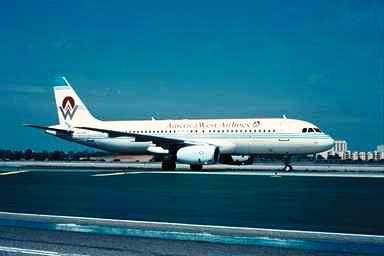
 |
|
|
|
|
||||
|
|
||||
 |
America West Airlines was claimed to be one of the greatest Airlines in the United States. It was formed in 1981, and started flying from Phoenix on August 1, 1983. Their fleet grew to over 90 aircraft after starting with just 3, six years earlier. The Airline originally flew in the western United States, as their name suggests, but later on extended their routes to all the states (including Canada and Hawaii in 1989 with Boeing 747s.) Within June 27th, 1991 and August 1994 American West flew under Chapter 11 bankruptcy protection. They were forced to reduce their fleets and give up their unprofitable routes. This plan of cost reduction succeeded in producing funds, and they finally rose from Chapter 11 protection. The Airline launched America West Express Commuter in October of 1992, with a code sharing agreement with Mesa Airlines and others. Continental Airlines and Mesa Airlines are both shareholders in America West. |
|||
|
America West was one of the first airlines to use extensive
"cross-utilization", in which employees were trained in a variety of
airline jobs, such as pilots trained in dispatch, and both baggage
handlers and flight attendants being trained as gate agents. America
West also started as a "full service" airline, in contrast with
Southwest Airlines, the discount air carrier competing in many of the
same markets. America West also utilized an aggressive employee stock
ownership program, in which new employees were required to invest 20% of
their salary in company stock, providing a steady flow of cash as the
company grew.
In 1985, America West had grown to the point that no more gate space was
available at
The airline's rapid growth continued in 1986, with the airline greatly
expanding its fleet, primarily with Boeing 757s purchased from Northwest
Airlines after Northwest bought out Republic Airlines, as well as the
acquisition of a number of De Havilland Canada Dash 8 aircraft for local
service from
The rapid growth of America West resulted in large operating losses for
the airline, and by 1986 the company was on the verge of bankruptcy.
Originally slated to occupy the vast majority of the gates in the
under-construction Terminal 4, America West had to reduce its commitment
to the city of
As 1989 opened the airline explored destinations beyond the |
||||
|
In 1990, the airline moved into the new Terminal 4 and also took the
delivery of several Airbus A320 aircraft that were destined for the
now-defunct Braniff Airways. The A320s were sold to America West at a
steep discount. Braniff had assumed the Airbus A320 order after
purchasing the original order rights from Pan Am, another troubled
carrier. The United States Department of Transportation classified
America West Airlines a major airline.
Despite these developments, the
airline continued to lose money. The operating expenses at the new
Terminal 4 were much higher than previous expenses in Terminal 3's
temporary concourse. The
America West operated in bankruptcy from 1991 to 1994. As part of its
restructuring, the employee stock became worthless, the
The bankruptcy forced a number of changes on the management side as
well. Founder and CEO Ed Beauvais was removed as CEO, but remained on
the board of directors, while Mike Conway, who had been with the airline
since its start, was appointed as the new CEO, although he in turn would
leave the airline in 1994, replaced by A. Maurice Myers. America West's
Flight Attendants also unionized in 1993, a move which ended the
cross-utilization between customer service agents, flight attendants,
and ground agents. Many maintenance and training functions that were
previously operated by America West in-house were also outsourced during
the bankruptcy.
Finally, in 1994 America West managed to secure a reorganization that
allowed it to come out of bankruptcy, with a large portion of the
airline owned by a partnership including Mesa Airlines and Continental
Airlines, which resulted in code-sharing agreements with these airlines.
To help reinvigorate the airline as it emerged from bankruptcy, a number
of consumer-visible changes occurred, including a new color scheme and
logo (used until the merger with US Airways), new livery, E-ticket, and
online ticket purchasing (in 1996). The airline continued ordering
Airbus A320 aircraft, and gradually started retiring its older Boeing
737-200 aircraft.
In the 1990s, America West Airlines opened an east coast hub at
At the end of 2001, America West Airlines received a loan of $380
million from the Air Transportation Stabilization Board. As of April
2005, the remaining balance on the loan was $300 million. On October 19,
2005, the loan was repaid when the debt was refinanced with other
lenders. In February 2003, America West Airlines announced plans to close
the |
| ?AvStop Online Magazine Contact Us Return To News |